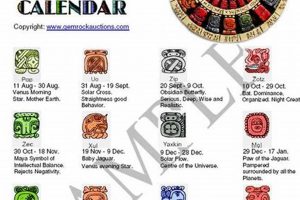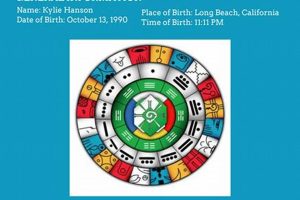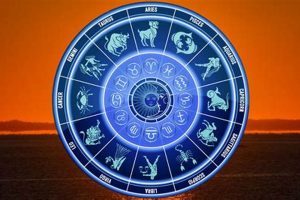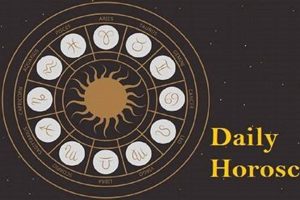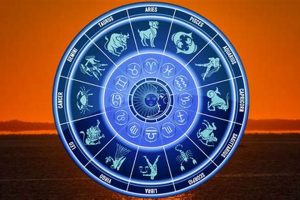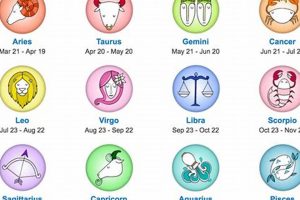A system rooted in ancient Mesoamerican traditions uses a complex calendar system to interpret personality traits, life paths, and destinies. This system, based on the cycles of the Mayan calendar, including the Tzolkin (sacred calendar) and the Haab (civil calendar), provides a unique perspective different from Western astrology. A personalized interpretation typically involves calculations based on one’s birth date, correlating it with specific Mayan day signs, numbers, and deities, offering insight into an individual’s characteristics and potential.
This Mesoamerican divination system offers a lens through which individuals can understand their strengths, weaknesses, and purpose in life. Rooted in a rich cultural heritage, these practices provide a connection to ancestral wisdom and a framework for self-discovery. By understanding the energies associated with their birth date within the Mayan calendar system, individuals can gain insights into their inherent nature and navigate life’s challenges with greater awareness. Historically, these traditions played a significant role in Mayan society, informing decisions related to agriculture, ceremonies, and daily life.
Further exploration of this fascinating system involves understanding the intricacies of the Mayan calendar, the meanings of the day signs, and the roles of the associated deities. This knowledge allows for a deeper appreciation of the cultural and historical significance of these practices and provides the foundation for a more personalized and meaningful interpretation.
Tips for Understanding Your Mayan Astrological Profile
Gaining deeper insights from a Mesoamerican astrological profile requires careful consideration of several key factors. The following tips provide guidance for navigating this complex system.
Tip 1: Accurate Birth Date: Ensure precise birth date information, including the day, month, and year, as this forms the foundation for accurate calculations within the Mayan calendar system.
Tip 2: Consult Reputable Sources: Seek guidance from knowledgeable practitioners or resources specializing in Mayan astrology to ensure accurate interpretations and avoid misinformation.
Tip 3: Understand the Calendar System: Familiarize oneself with the intricacies of the Tzolkin and Haab calendars, as these are fundamental to interpreting Mayan astrological information.
Tip 4: Explore Day Signs and Numbers: Research the meanings associated with the Mayan day signs and numbers corresponding to one’s birth date to understand their influence on personality and destiny.
Tip 5: Consider the Influence of Deities: Explore the roles and characteristics of the Mayan deities associated with one’s birth date to gain a deeper understanding of the energies at play.
Tip 6: Integrate Insights, Don’t Dictate: Use these astrological insights as a tool for self-reflection and growth, rather than allowing them to dictate life choices.
Tip 7: Lifelong Learning: This intricate system offers a wealth of knowledge; continued exploration and learning will deepen understanding over time.
By considering these tips, individuals can gain a more comprehensive and meaningful understanding of their Mayan astrological profile, facilitating a deeper connection to this ancient tradition and its potential for self-discovery.
Ultimately, exploring a Mesoamerican astrological profile offers a unique opportunity to understand oneself within a broader cosmological framework.
1. Tzolkin Calendar
The Tzolkin calendar forms the foundation of a Mayan astrological birth chart. This sacred 260-day calendar, composed of 13 numbers and 20 day signs, generates a unique combination for each day. This daily energetic signature provides a core element for interpretation within the broader context of the birth chart. The Tzolkin influences personality traits, inherent strengths and weaknesses, and provides insight into an individual’s life purpose. For example, someone born on 1 Imix might be associated with leadership qualities and primal creative energy, while someone born on 8 Kan might exhibit traits of organization and practicality.
Understanding the Tzolkin is essential for deciphering the nuances of a Mayan birth chart. Each day sign possesses specific characteristics, and its interaction with the accompanying number further refines the interpretation. The cyclical nature of the Tzolkin reveals recurring energetic patterns, influencing different life phases. In practical application, this understanding offers individuals a framework for self-reflection and personal growth. By recognizing the influences of their Tzolkin birth date, individuals can navigate challenges with greater awareness and align their actions with their inherent energetic predispositions.
In essence, the Tzolkin calendar serves as a key to unlocking the deeper meaning embedded within a Mayan astrological birth chart. Its influence provides valuable insight into an individual’s inherent nature, offering a pathway for self-discovery and a deeper understanding of one’s place within the cosmos. While other components like the Haab calendar contribute further details, the Tzolkin remains central to this ancient Mesoamerican system of divination.
2. Haab Calendar
The Haab calendar plays a crucial role in understanding a Mayan astrology birth chart, complementing the Tzolkin calendar. This 365-day solar calendar, comprised of 18 months with 20 days each and a five-day period known as Wayeb, anchors the birth chart to the solar year. While the Tzolkin reveals energetic predispositions, the Haab provides context related to the individual’s experience within the cycles of nature and the seasons. The interplay between these two calendars provides a more complete astrological picture.
- Agricultural Significance
The Haab’s close alignment with the solar year made it essential for agricultural practices. Specific months corresponded to planting, harvesting, and other agricultural activities. Within a birth chart, the Haab month of birth could suggest a connection to specific natural cycles and rhythms. For example, someone born during the month of Pop might be associated with leadership and community, reflecting the time of harvest and communal celebration.
- Connection to Natural Cycles
The Haab reflects the cyclical nature of life, death, and rebirth inherent in the natural world. Each month carries specific energies associated with the changing seasons. This connection provides additional context for understanding an individual’s personality and life path. Someone born during Wayeb, the five-day period considered a time of transition and reflection, might possess introspective qualities.
- Interplay with the Tzolkin
The combined reading of the Tzolkin and Haab creates a Calendar Round, a 52-year cycle representing the intersection of sacred and secular time. This combined reading provides a more nuanced and specific interpretation of the birth chart, revealing recurring patterns and influences throughout an individual’s life. A specific Tzolkin/Haab combination occurs only once every 52 years, highlighting the uniqueness of each individual’s astrological profile.
- Long Count Calendar Integration
While less directly related to individual birth charts, the Mayan Long Count calendar, tracking longer historical cycles, provides a broader cosmological context. This calendar, which played a crucial role in Mayan prophecies and historical records, adds another layer of depth to understanding the individual’s place within the larger cycles of time.
By understanding the influence of the Haab calendar alongside the Tzolkin, individuals gain a richer understanding of their Mayan astrological profile. The Haab grounds the individual’s energetic blueprint within the cycles of nature and time, offering valuable insights into their connection to the physical world and their place within the greater cosmos. This combined reading offers a more holistic perspective on personal destiny and potential life path, making the Haab an integral component of a Mayan astrology birth chart.
3. Day Signs (Glyphs)
Day signs, represented by glyphs, function as fundamental building blocks within a Mayan astrology birth chart. Each of the 20 day signs embodies unique characteristics and energies, influencing personality traits, natural inclinations, and life path potentials. These glyphs, more than just symbols, represent archetypal energies woven into the fabric of Mayan cosmology. Their presence within a birth chart provides a crucial lens for understanding an individual’s inherent nature and potential destiny.
The influence of a day sign operates on multiple levels. For example, Imix, often associated with creation and primal energy, might suggest an individual with strong leadership qualities and a pioneering spirit. Conversely, Ik, representing wind and breath, might indicate someone with intellectual curiosity and a talent for communication. These are not deterministic pronouncements, but rather indications of potential strengths and tendencies. Understanding one’s day sign provides a framework for self-awareness, allowing individuals to recognize and cultivate their inherent gifts. Furthermore, the interaction between the day sign and its accompanying number (1-13 in the Tzolkin) adds further nuance to the interpretation. A 1 Imix carries a different energy than a 4 Imix, highlighting the complexity and depth of this system.
In summary, day signs serve as essential components within a Mayan astrology birth chart. Their influence shapes individual characteristics and provides valuable insights into life purpose and potential. By understanding the symbolism and energetic qualities of their day sign, individuals can gain a deeper understanding of themselves and their place within the intricate tapestry of Mayan cosmology. This understanding, however, requires careful consideration within the context of the entire birth chart, acknowledging the interplay of other elements such as the accompanying number, the Haab calendar position, and the associated Mayan deities, to achieve a comprehensive interpretation.
4. Numbers (Energies)
Numbers hold significant weight within a Mayan astrology birth chart, representing distinct energetic vibrations that influence the interpretation of the day signs and overall chart dynamics. These numbers, ranging from 1 to 13 within the Tzolkin calendar, are not merely quantitative values but rather qualitative forces, each imbued with specific characteristics and influencing the expression of the associated day sign. Understanding the energetic qualities of these numbers provides essential context for a comprehensive interpretation of the birth chart.
- The Power of One (Hun)
Representing unity, beginnings, and independent action, Hun amplifies the core energy of the associated day sign. A day sign paired with Hun emphasizes self-reliance and leadership potential. For instance, a Hun Imix individual might exhibit strong creative initiative and a pioneering spirit.
- The Duality of Two (Ca)
Ca introduces the principle of duality, partnership, and balance. This number often signifies the importance of relationships and collaboration. A Ca Kan individual, for example, might demonstrate strong diplomatic skills and an ability to navigate complex interpersonal dynamics.
- The Catalytic Three (Ox)
Ox embodies movement, growth, and creative expression. It often indicates a period of expansion and the manifestation of ideas. Someone born on an Ox Eb day might be highly communicative and possess a natural talent for artistic expression.
- The Stability of Four (Can)
Can represents stability, foundation, and practicality. This number often emphasizes the importance of structure and organization. A Can Ik individual might be highly analytical and possess a strong sense of groundedness.
The interplay between the numbers and day signs within the Tzolkin calendar creates a complex matrix of energetic influences. Each number modifies and refines the expression of the day sign, adding depth and nuance to the interpretation of the birth chart. This intricate system highlights the importance of understanding both the individual characteristics of the numbers and their combined influence with the day signs to gain a comprehensive understanding of a Mayan astrology birth chart. By recognizing these energetic patterns, individuals can gain valuable insights into their strengths, challenges, and potential life path. Further exploration of the remaining numbers (5 through 13) reveals a deeper understanding of this intricate system and its impact on individual destinies.
5. Mayan Deities
Mayan deities play an integral role in the interpretation of a Mayan astrology birth chart, acting as powerful archetypal influences that shape individual characteristics and destiny. Each day within the Mayan calendar system aligns with specific deities, imbuing individuals born on those days with particular energies and predispositions. These deities are not simply symbolic figures but rather represent potent forces that interact with the individual’s energetic blueprint, influencing personality traits, life path, and potential challenges. Understanding the characteristics and domains of the associated deity provides valuable insight into a birth chart’s deeper meaning.
For example, an individual born on a day associated with Itzamn, the god of creation and wisdom, might exhibit a strong intellectual curiosity, a talent for artistic expression, and a deep connection to spiritual matters. Conversely, someone born under the influence of Ix Chel, the goddess of the moon, weaving, and medicine, might possess nurturing qualities, a strong intuition, and an affinity for healing arts. These are not deterministic assignments, but rather indications of potential strengths and inclinations. The deities provide a framework for understanding the energetic influences at play within an individual’s life, offering guidance for navigating challenges and embracing opportunities. The interaction between the deity’s energy and the individual’s unique energetic blueprint creates a complex interplay of influences, shaping personal destiny.
In essence, the Mayan deities serve as powerful lenses through which to interpret a birth chart. Their presence adds a layer of depth and complexity to the understanding of individual characteristics, motivations, and potential life paths. Recognizing the influence of the associated deity provides a valuable tool for self-discovery and personal growth, allowing individuals to connect with their inherent strengths and navigate their lives with greater awareness. This connection to the divine pantheon enriches the understanding of Mayan astrology and its potential for providing profound insights into the human experience. Further exploration of individual deities and their associated characteristics unveils a rich tapestry of Mayan cosmology and its practical application in understanding individual destinies.
6. Personal Destiny
Within Mayan cosmology, the concept of personal destiny is intricately linked to the individual’s birth chart. This personalized cosmic blueprint, derived from the precise date of birth within the Mayan calendar system, offers insights into one’s inherent nature, life purpose, and potential challenges. The birth chart serves as a guide, illuminating a predetermined path, yet allowing for individual agency in navigating its course. This intricate system proposes that destiny is not a fixed, immutable endpoint, but rather a dynamic interplay between predetermined influences and individual choices.
The Mayan birth chart outlines potential strengths, weaknesses, and karmic predispositions. For instance, an individual born under the sign of Oc, associated with leadership and independence, might be predisposed towards a path of authority and self-reliance. However, the accompanying number and associated deity add further nuance, indicating potential challenges and opportunities related to this predisposition. Challenges might include tendencies toward dominance or isolation, while opportunities might involve developing collaborative leadership skills and using their independence for the benefit of the community. This example illustrates how the birth chart provides a framework for understanding one’s inherent tendencies, while also acknowledging the potential for growth and transformation through conscious choices.
Understanding one’s Mayan birth chart does not dictate a predetermined life, but rather offers a roadmap for navigating life’s journey. It provides a framework for self-awareness, allowing individuals to recognize their inherent strengths and weaknesses, and to make informed choices aligned with their unique energetic blueprint. While the birth chart suggests potential life paths and challenges, it also emphasizes the individual’s capacity to shape their destiny through conscious action and mindful engagement with the energies presented. By understanding these inherent predispositions, individuals can navigate life’s complexities with greater awareness and strive towards fulfilling their unique potential within the context of their predetermined cosmic influences.
Frequently Asked Questions
This section addresses common inquiries regarding the interpretation and application of Mayan astrological birth charts.
Question 1: How does a Mayan birth chart differ from a Western astrology chart?
Mayan astrology, rooted in Mesoamerican traditions, utilizes different calendar systems (Tzolkin and Haab) and focuses on day signs, numbers, and deities distinct from the zodiac signs and planets of Western astrology. While both systems offer insights into personality and destiny, they employ different frameworks and interpretations.
Question 2: Is a Mayan birth chart predictive of future events?
A Mayan birth chart is not a tool for fortune-telling. Instead, it provides a framework for understanding inherent energetic predispositions and potential life paths. It offers insights into strengths, weaknesses, and karmic influences, but does not predict specific events. Individual choices and external factors also shape life experiences.
Question 3: How accurate are online Mayan birth chart generators?
Accuracy varies depending on the source. Thorough research and consultation with reputable practitioners are recommended. Understanding the intricacies of the Mayan calendar system is crucial for accurate interpretation, and automated generators may not always capture these nuances.
Question 4: Can understanding one’s Mayan birth chart lead to personal growth?
Self-awareness is a key benefit. By understanding inherent strengths, weaknesses, and karmic influences, individuals can make informed choices, navigate challenges with greater awareness, and cultivate their potential for personal development. It offers a framework for self-reflection and empowers individuals to take proactive steps towards growth.
Question 5: What is the significance of the Calendar Round?
The Calendar Round is the 52-year cycle created by the synchronization of the Tzolkin and Haab calendars. This cycle represents a significant timeframe within Mayan cosmology, influencing recurring patterns and themes throughout an individual’s life. A specific Tzolkin/Haab combination repeats only once every 52 years, highlighting the uniqueness of each individual’s astrological profile within this cycle.
Question 6: How can one learn more about Mayan astrology?
Reputable books, workshops, and consultations with knowledgeable practitioners are valuable resources. Dedicated research and a commitment to understanding the cultural context surrounding Mayan astrology are essential for accurate and meaningful interpretation. Continuous learning enhances comprehension of this complex and rich system.
By addressing these common inquiries, individuals can gain a clearer understanding of Mayan astrology’s applications and limitations. Further exploration through credible sources and ongoing learning will deepen comprehension of this ancient Mesoamerican system.
Exploring the Mayan calendar’s complexities unveils a rich tapestry of ancient wisdom and cosmological insights. Further sections will delve into the intricacies of the Tzolkin and Haab calendars, offering a deeper understanding of their interplay and significance within Mayan astrology.
Mayan Astrology Birth Chart
Exploration of a Mayan astrological birth chart reveals a complex system rooted in ancient Mesoamerican traditions. The interplay of the Tzolkin and Haab calendars, combined with the influence of day signs, numbers, and deities, provides a framework for understanding individual characteristics, potential life paths, and karmic predispositions. This system offers not a prediction of future events, but rather a tool for self-discovery and personal growth, empowering individuals to navigate life’s journey with greater awareness. The significance of the Calendar Round, the interplay of energies within the birth chart, and the connection to Mayan deities all contribute to a deeper understanding of one’s place within the cosmos.
This ancient system offers a unique lens through which to understand the human experience. Further exploration and research into Mayan cosmology and calendrical systems will undoubtedly yield a richer appreciation for the depth and complexity of this ancient practice. By engaging with these traditions respectfully and with an open mind, individuals can gain valuable insights into their own nature and the interconnectedness of all things. The journey of understanding a Mayan astrology birth chart is a journey of self-discovery, offering a path towards greater awareness and a deeper connection to the wisdom of ancient Mesoamerica.


